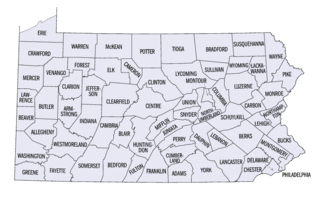
This is a list of properties and districts listed on the National Register of Historic Places in Pennsylvania. As of 2015, there are over 3,000 listed sites in Pennsylvania. Sixty-six of the 67 counties in Pennsylvania have listings on the National Register; Cameron County is the only county without any sites listed.

This is a list of the National Register of Historic Places listings in Montgomery County, Pennsylvania.
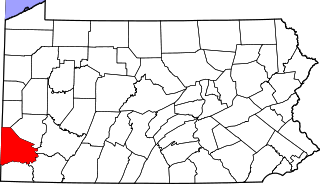
This is a list of the National Register of Historic Places listings in Washington County, Pennsylvania.

This is a list of the National Register of Historic Places listings in Erie County, Pennsylvania.

This is a list of the National Register of Historic Places listings in Northampton County, Pennsylvania.
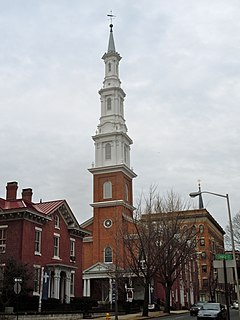
Trinity Lutheran Church is a historic Lutheran church at 6th and Washington Streets in Reading, Berks County, Pennsylvania. The current church building was built in 1791, and is a two-story, three bays by five-bays, red brick building with stone and wood trim in the Georgian style. The second floor was added in 1851. It has a square bell tower and steeple last replaced in 1963. The front facade features a columned portico added in 1900.
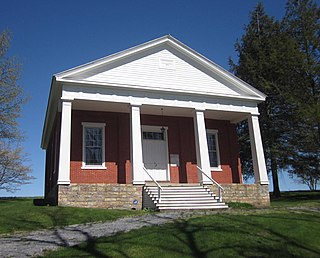
Buffalo Presbyterian Church is a historic Presbyterian church located at Buffalo Township, Union County, Pennsylvania. It was built in 1846, and is a one-story, brick and wood frame building, three bays wide and four bays deep. It features a full-width portico supported by four square columns.

The Harry Packer Mansion, is a historic home located at Jim Thorpe, Carbon County, Pennsylvania. The mansion was designed by architect Addison Hutton and built in 1874. It is a 2 1⁄2-story, three-bay-wide, red-brick dwelling in the Italianate style. The front facade features a verandah constructed of green Vermont sandstone and a bell tower attached to the two-story extension. It was given as a wedding gift from his father Asa Packer.
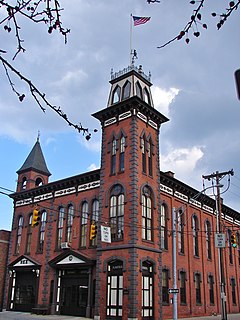
The Laurel–Rex Fire Company House, consisting of the Laurel Engine House and Rex Hook & Ladder Company House, is a historic fire station located at York, Pennsylvania, York County, Pennsylvania. It was built in 1878, and is a two-story, brick building in the Italianate style. It measures 48 by 96 feet. It has a three-story bell tower on the northwest corner and a second atop the roof. The original engine house was expanded in 1887 with a stable and in 1888 with a ladder house.
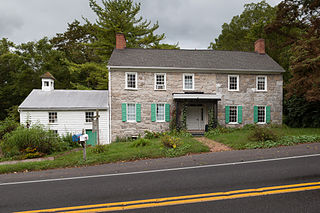
Daniel Royer House is a historic home located at Woodbury Township, Blair County, Pennsylvania. It was built in at least two sections. The oldest section is a three-bay, two-story stone section built about 1815. Built about the same time was a 1 1⁄2-story clapboard section. A two-bay by five-bay wing addition was probably built in the 1840s. It features a two-story porch across the length of the addition. The house is associated with the Royer family; early settlers of Woodbury Township and prominent in the local iron making industry.
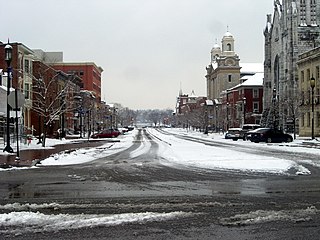
Harrisburg Historic District is a national historic district located at Harrisburg, Dauphin County, Pennsylvania. The district includes 340 contributing buildings and 1 contributing site in a 19th-century residential area of Harrisburg. It contains the original core of the city. Located in the district is Harris Park, which unifies the district. Notable buildings include the Y.M.C.A. (1932), William McClay Mansion (1792), Grace Methodist Church (1871), St. Stephen's Episcopal Cathedral (1826), St. Michael's Lutheran Church (1906), Cathedral of Saint Patrick (1907) and the Unit Row Houses. The John Harris Mansion is located in the district and listed separately.

Houseknecht Farm is a historic house and farm located at Moreland Township, Lycoming County, Pennsylvania. The historic buildings are the farmhouse, three-gabled barn, three-bay machine / corn shed ; granary with small attached garage ; small machine shed ; smokehouse ; and summer kitchen / butcher house with attached woodshed. The farmhouse is a two-story, four-bay, two-door house with a two-story ell.

The Byrd Leibhart Site, designated 36 YO 170 is a historic archaeological site located in Native Lands County Park at Lower Windsor Township, York County, Pennsylvania. It was the site of a late 17th-century fortified settlement. Artifacts were first discovered in 1929, and an excavation undertaken by the Pennsylvania Historical and Museum Commission took place in July–August 1970. The excavation identified three cemeteries, a village component, stockade, and a longhouse. The excavations uncovered a range of native and European trade goods dating to the late 17th century.
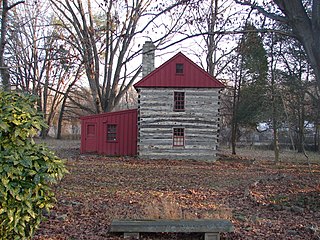
Pusey–Crozier Mill Historic District, also known as Pusey Plantation and Landingford, is a historic mill complex and national historic district located at Upland, Delaware County, Pennsylvania. The district includes nine contributing buildings, one contributing site, and one contributing structure, at the site of the first grist mill and sawmill erected by the English Quakers in 1682. They are the Pennock Log House (1790), schoolhouse (1849), four single houses (1850), large double house (1850s), mid-19th century barn, and the original mill site, headrace, and tail race. The Caleb Pusey House is located in the district and separately listed on the register.
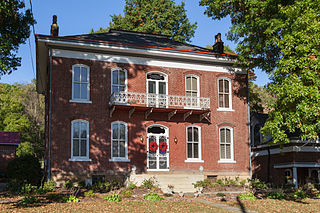
McClelland–Grimes Farm is a historic farm located at Morgan Township and Washington Township in Greene County, Pennsylvania. The contributing resources are the brick main house, brick combination ice house / smoke house, timber frame barn (1883), wood frame sheep barn, wood frame wash house, early 20th century corn crib, wood frame scale shed, mid-20th century balloon frame poultry house, poured concrete cistern, and walled spring. The surrounding farm property is a contributing site.

Roberts Farm Site (36LA1) is a historic archaeological site located above the Conestoga River at Manor Township in Lancaster County, Pennsylvania. It underwent excavation in 1931-1932 and in 1971 by the Pennsylvania Historic and Museum Commission. The excavations identified the presence of a substantial, fortified Susquehannock Indian village and cemetery from the Late Woodland / Protohistoric period. Settlement was from the Late Archaic period through about 1650.

Shenks Ferry Site (36LA2) is a historic archaeological site located above Grubb Creek at Martic Township in Lancaster County, Pennsylvania. It underwent excavation in 1930-1931 and in 1973 by the Pennsylvania Historic and Museum Commission. The excavations identified the presence of a village and seasonal campsites dated to the Late Woodland period.
The National Register Information System (NRIS) is a database of properties that have been listed on the United States National Register of Historic Places. The database includes more than 84,000 entries of historic sites that are currently listed on the National Register, that were previously listed and later removed, or that are pending listing. The database includes approximately 45 pieces of data for each listed property. Accuracy of the NRIS database may be imperfect. For example, a 2004 paper addressed accuracy of spatial location data for part of the NRIS content.
























